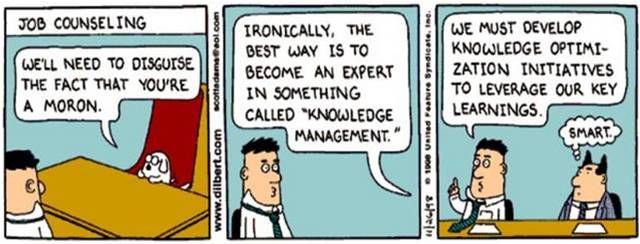This is Part 2 of a TBD # of parts series:
- What & Why KM – The Challenge
- Who and How KM – The Alignment
- Identifying Experts & Assets – The Analysis
- Where & When KM – The Project (phase 1)
- Advanced KM – The Project (phase 2)
In Part 1 of this series I reviewed some of the common problems and challenges that may be warning signs that a company could do with some good solid Knowledge Management (KM).
Today we’ll take a look at who should be charged with driving KM in an organization, who needs to be part of the solution, and how to get it done. As ever, comments welcome and appreciated.
Align KM with company’s key objectives
KM is not a small side project. It requires significant resources and commitment which starts from executive leadership. In order to transform an organization, the metrics and goals of KM should align with the company’s targets such as sales, revenue or customer/partner satisfaction levels.
Given KM might be considered a “new” function, there might be a temptation to go hire “KM experts” to help in the analysis and planning. While this may be helpful, it could be a costly endeavor and they should not be the main leaders of the KM initiative, rather it is critical that the KM team and project be led by an internal employee. So who should own and drive KM for the company? The characteristics of the individual or group should be profiled as follows:
1. Has good and broad relationships across the organization, interacting with all departments
2. Has strong planning, organizational, and analytical skills
3. Has a commitment to the overall goals and objectives of the company
4. Is equipped to manage upwards (to executives) and across departments (peers)
5. Is used to driving projects consisting of indirect reports
Sound like a familiar profile? Indeed, a good senior Product Manager(PM) is ideally suited to drive your KM initiative. Unless they don’t meet the criteria above (in which case you should question if they should be doing PM in the first place)
Make no mistake though, a full blown KM initiative is not a part-time endeavor, therefore it requires some additional resources and full blown commitment from the executive team and in some cases the board of directors. Additionally the KM Czar would not be able to simultaneously fulfill critical PM duties in parallel. This should be a dedicated project for the duration.
The first step in any KM project should be to create a KM Charter upon which there should be no ambiguity and various department heads who are required to invest time and effort need to sign up (literally get some signatures) and commit. The contents of this charter might look something like this:
| 1. Executive Summary 2. Introduction 3. Business Need or Opportunity 4. Business Objectives 5. Project Description 5.1. Overview 5.2. KM Group – Organization and Resources 5.3. Proposed Plan and Timeline 6. Dependencies and Related Efforts 7. Constraints, Assumptions and Risks 8. Appendix A – Budget Summary 9. Appendix B – Proposed KM leads across departments 10. Appendix C – Knowledge Engineer profile 11. Appendix D – This is Serious |
Furthermore, the opening summary of the charter should emphasize the seriousness of the KM initiative:
The KM Charter recommends and requests the following, without which the KM initiative cannot succeed:
- Immediate approval of resources. Exact structure of group and hiring of resources can depend on input provided by KM Subject Matter Experts (SME). The resource counts are for budgeting purposes only, initial ramp and kickoff of the initiative may consist of staffing through consultants as identified through reviews.
- Immediate approval for hiring subject matter experts to assist in the formulation of KM architecture and the resulting consumption/adoption by target audiences
- Commitment to include as part of each departments core responsibilities through job description additions, MBOs or other incentives an enforced cooperation, contribution and consumption of KM content and infrastructure.
Critical groups include: Engineering, Professional Services, Support, Training, Alliances and Sales Engineers - Approval for purchase of identified hardware/software infrastructure to support KM storage, management and dissemination. Including any training needed.
There are other risks and dependencies as listed later in the document, but immediate commitment and approval of the charter with full alignment by the executive team will allow the KM initiative to be launched.
Clearly stated goals and measurements should be defined up-front. An example is below:
| GOAL | MEASUREMENT |
| Establish an owning/responsible function that focuses on driving a process with dedicated resources for continuous knowledge capture and dissemination |
|
| Ensure all internal and external audiences are able to leverage to meet business goals |
|
Let me reiterate for the hundredth time in this article, no KM initiative should proceed unless the executive team are agreed and commitments from each individual department group responsible for contributing and managing content has been received. KM when not executed properly CAN BE A WASTE OF TIME, RESOURCES AND MONEY, as illustrated by the Dilbert cartoon. To avoid ridicule and to be successful, KM must be viewed in all seriousness as a major contributor to the company’s goals and objectives for growth. In the next post, I will delve into how to get started and present a content capture and sharing framework for a KM project illustrating how groups should participate and contribute.


One thought on “Knowledge Management can change the way you do business (Pt2-The Alignment)”